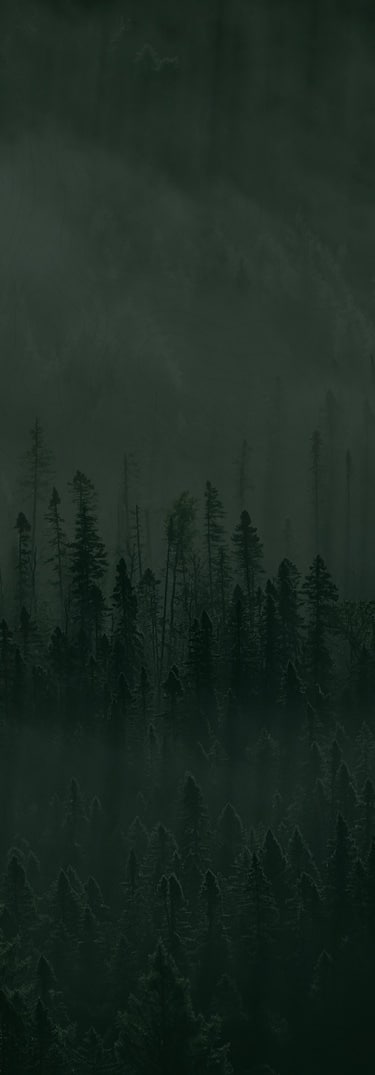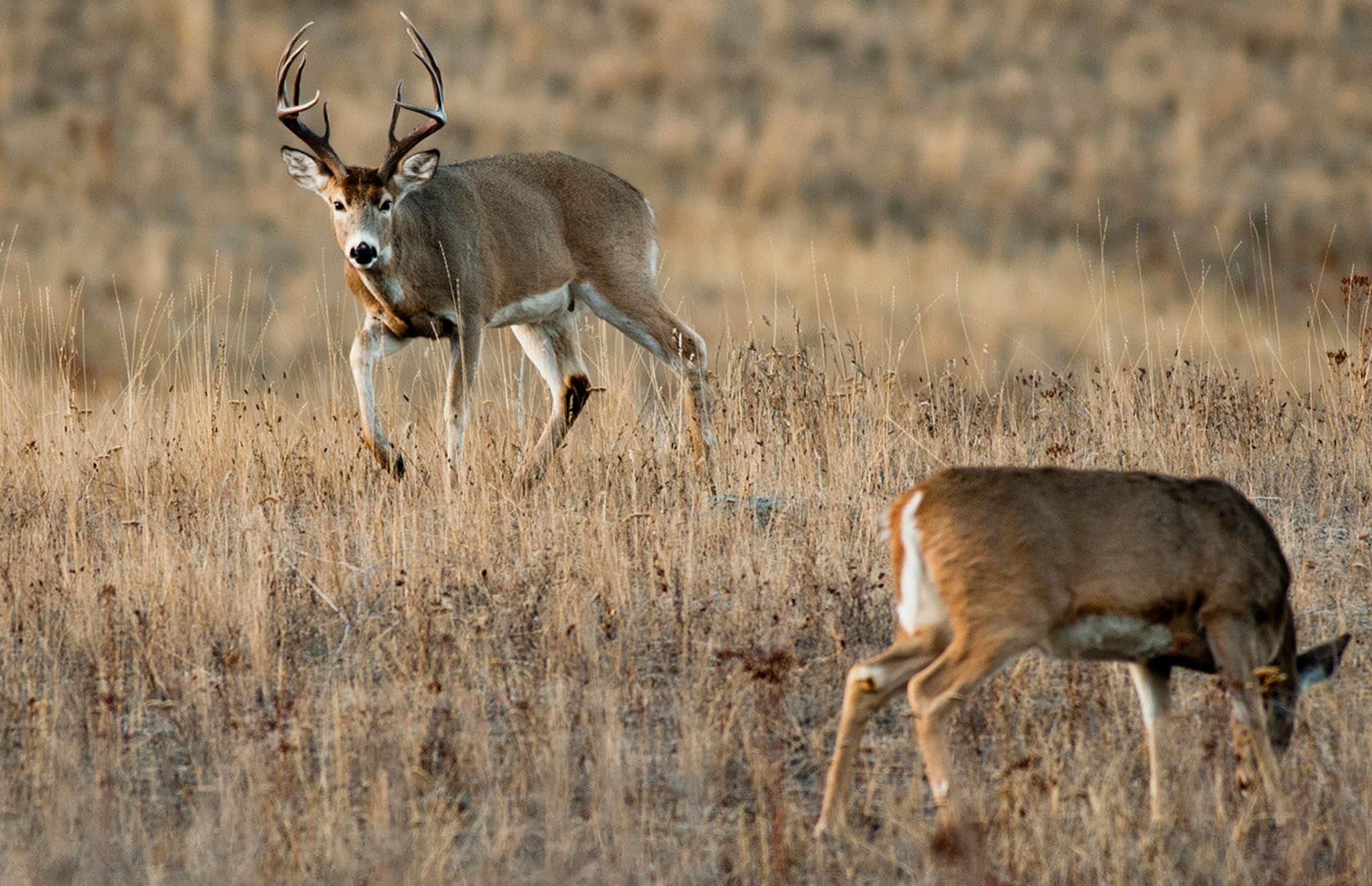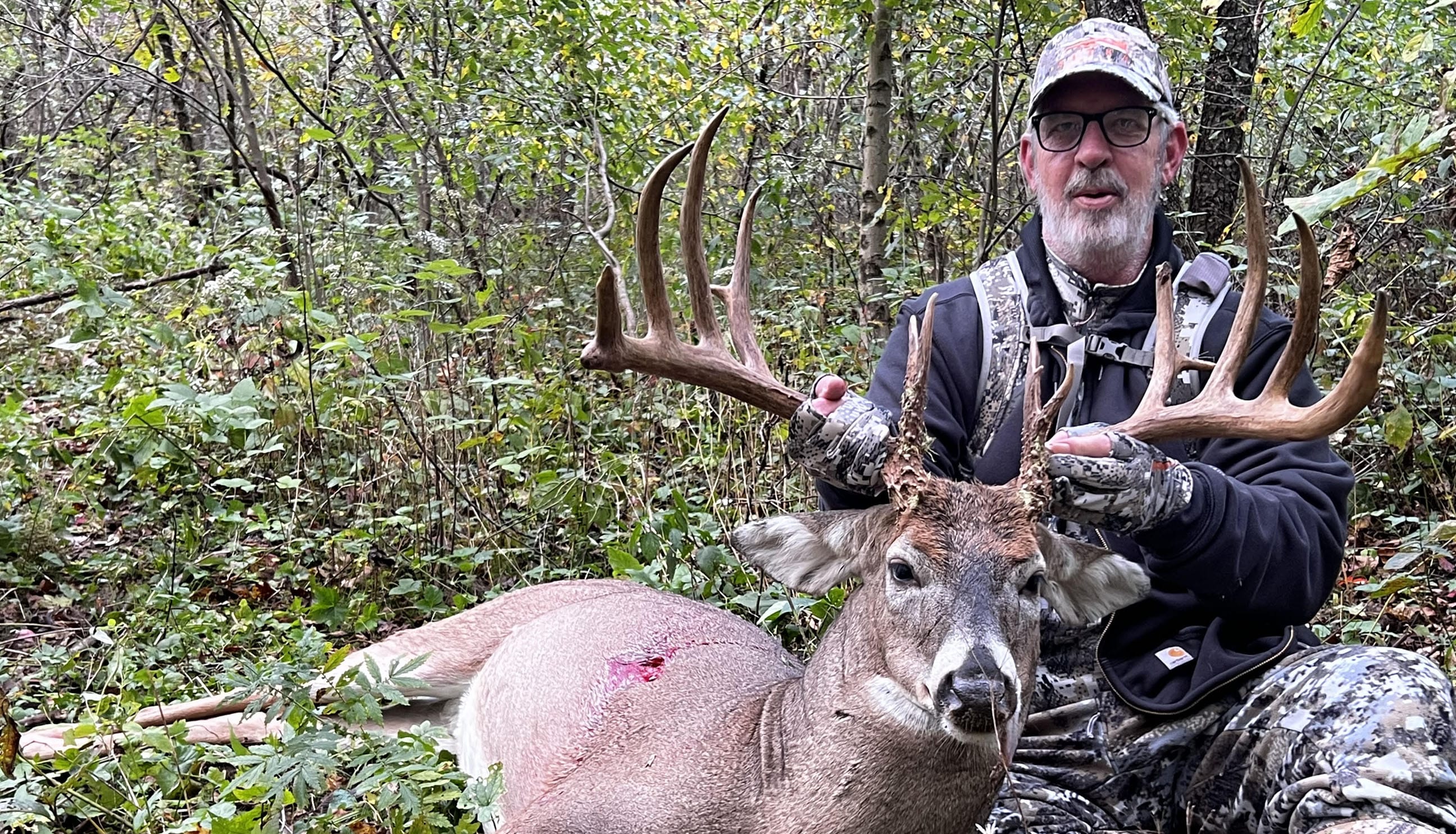Deer hunters everywhere take note: the HuntStand Whitetail Rut Map details the peak breeding period, also known as the rut, for white-tailed deer throughout the United States. Never before has whitetail breeding data been compiled and mapped to this level. It makes this map a unique and useful, interactive tool for deer hunters and managers alike. How do you get it? The Whitetail Rut Map is one of the features available in the Pro Whitetail upgrade. This ground-breaking map, and feature-packed upgrade, is ready to benefit deer hunters nationwide.
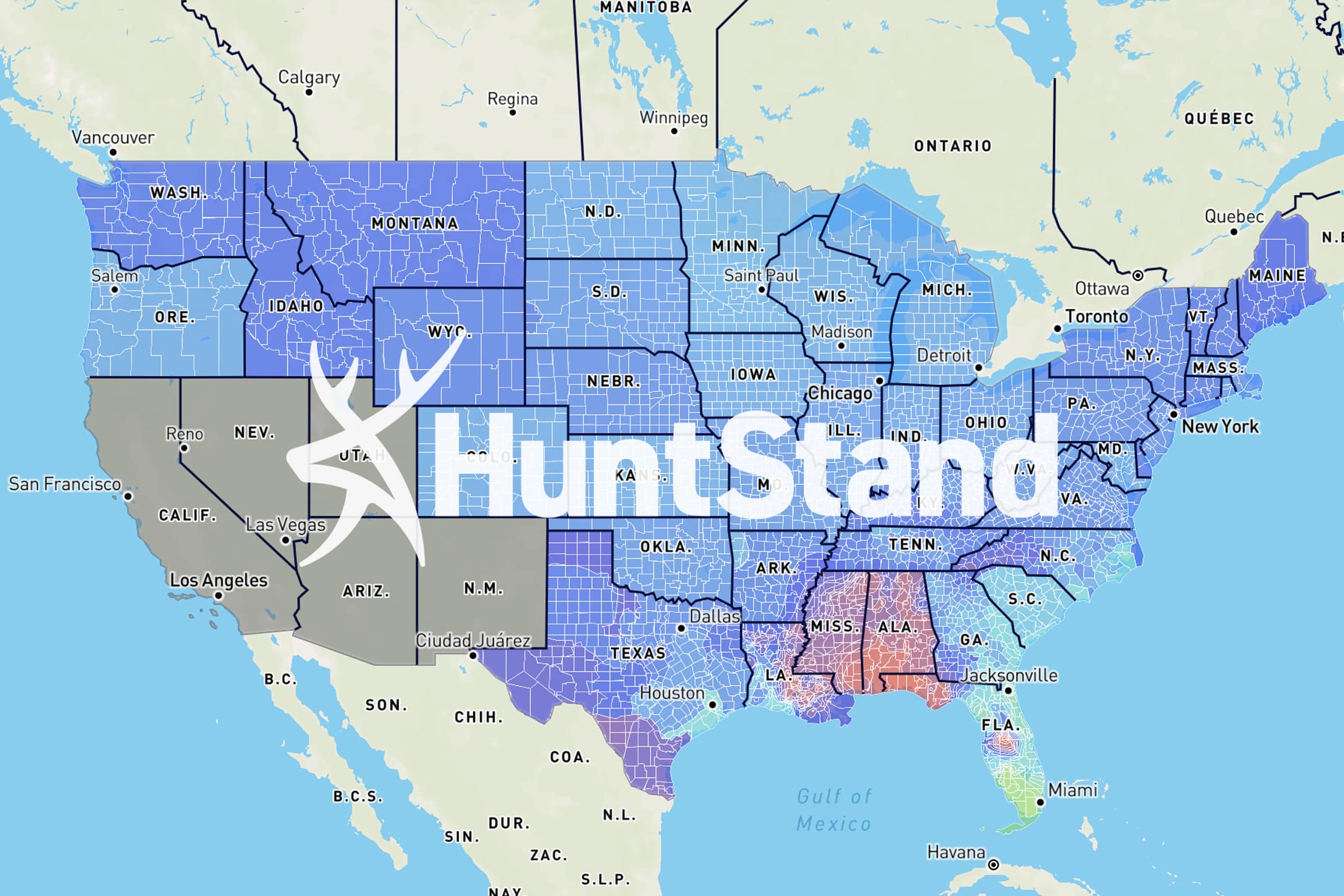

The ground-breaking HuntStand Whitetail Rut Map details the peak breeding period (Rut) for white-tailed deer throughout the United States. Never before has this data been compiled and mapped to this level.
Ground-Breaking Info
Let’s dive into this info-packed resource. The Whitetail Rut Map includes data from 4,240 counties, parishes, districts, or other geographic designations in 43 states. For the remainder of this feature the term “county” will be used collectively to represent all geographic designations. The map represents approximately 98 percent of the whitetail’s range in the United States. It does not include data for Coues whitetails, Key deer, mule deer, or black-tailed deer. However, the map does include data for Columbian white-tailed deer. No data are provided for seven states (CA, AZ, NM, NV, NM, AK, and HI) where whitetails are rare or absent.
Upgrade to Pro Whitetail: Get The Rut Map & More!
For the purposes of this map, “peak rut” is defined as the two-week period in which most does are bred. In most areas, greater than 50 percent of adult does (2.5+ year old) will breed during a two-week period, giving it the logical “peak breeding” distinction. It is not uncommon for doe fawns (0.5 years old) and some yearling does (1.5 years old) to breed later in the season, (outside of the “peak”) or during the so-called “second rut.” The second rut typically follows the peak rut by 28-30 days.
Data Backed by Science
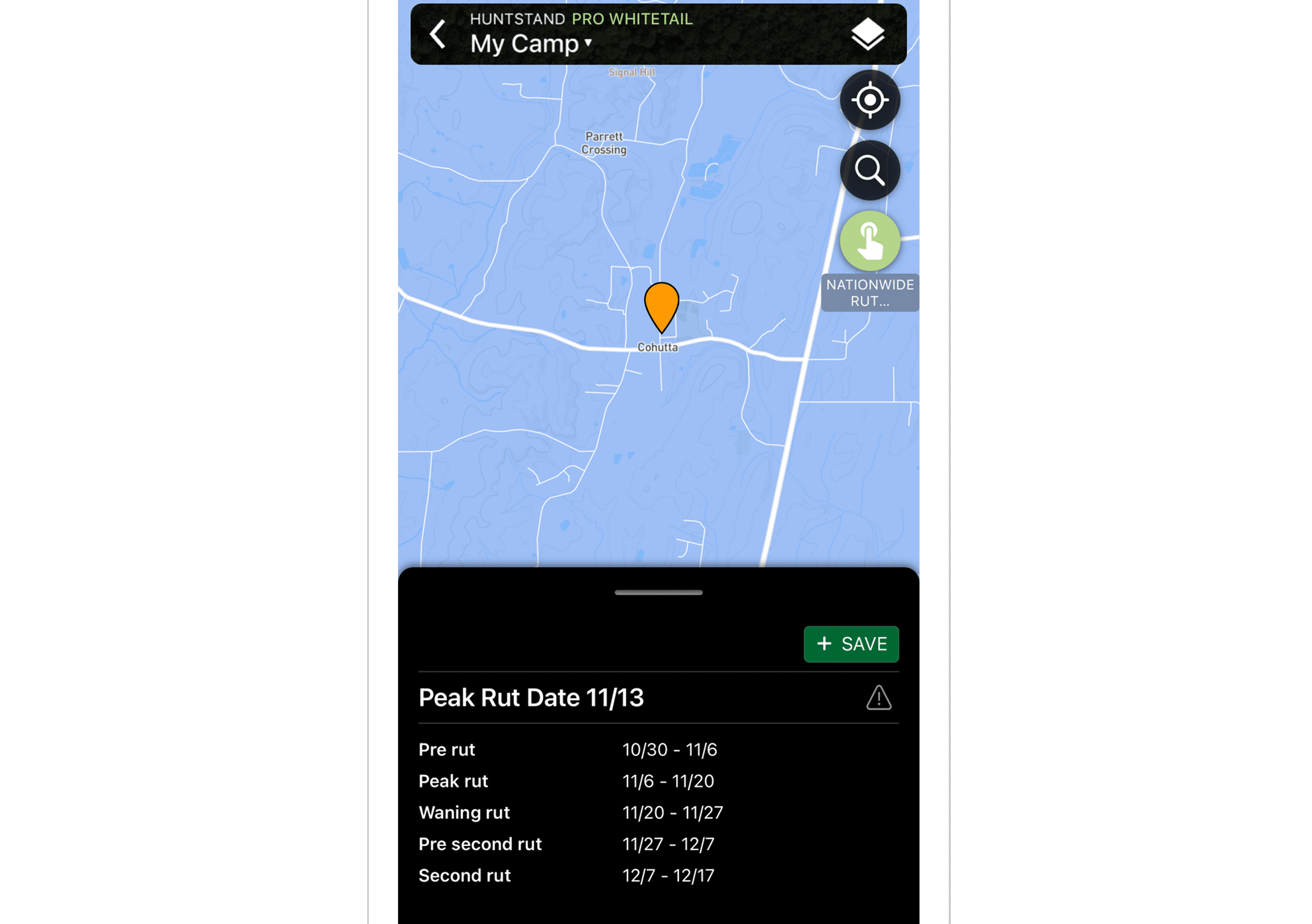

Simply tap the Whitetail Rut Map screen where you'd like to learn about rut data. Instantly, you'll see all important rut dates for that very specific area.
All data used for this map were provided by deer biologists from state fish and wildlife agencies in the 43 states represented on the map. Wherever possible, conception data from fetal measurements were used. Where such data were not available, timing of peak buck harvest and/or deer-vehicle collisions were used. In a few instances, anecdotal data from agency deer

“Covering more than 98 percent of the whitetail’s range in the United States, HuntStand’s new Whitetail Rut Map is the most-comprehensive and site-specific resource on whitetail breeding ever created.”
biologists, or fawn parturition data (where you can backdate to birth date), were used. All data were reviewed and standardized by HuntStand Wildlife Biologist Brian Murphy, a nationally respected whitetail expert. Murphy has more than 35 years of experience researching and managing white-tailed deer. Data was compiled and mapped by HuntStand Data Engineer Matt Roe.
Choosing the Best Treestand Tree on the Property
Key Findings
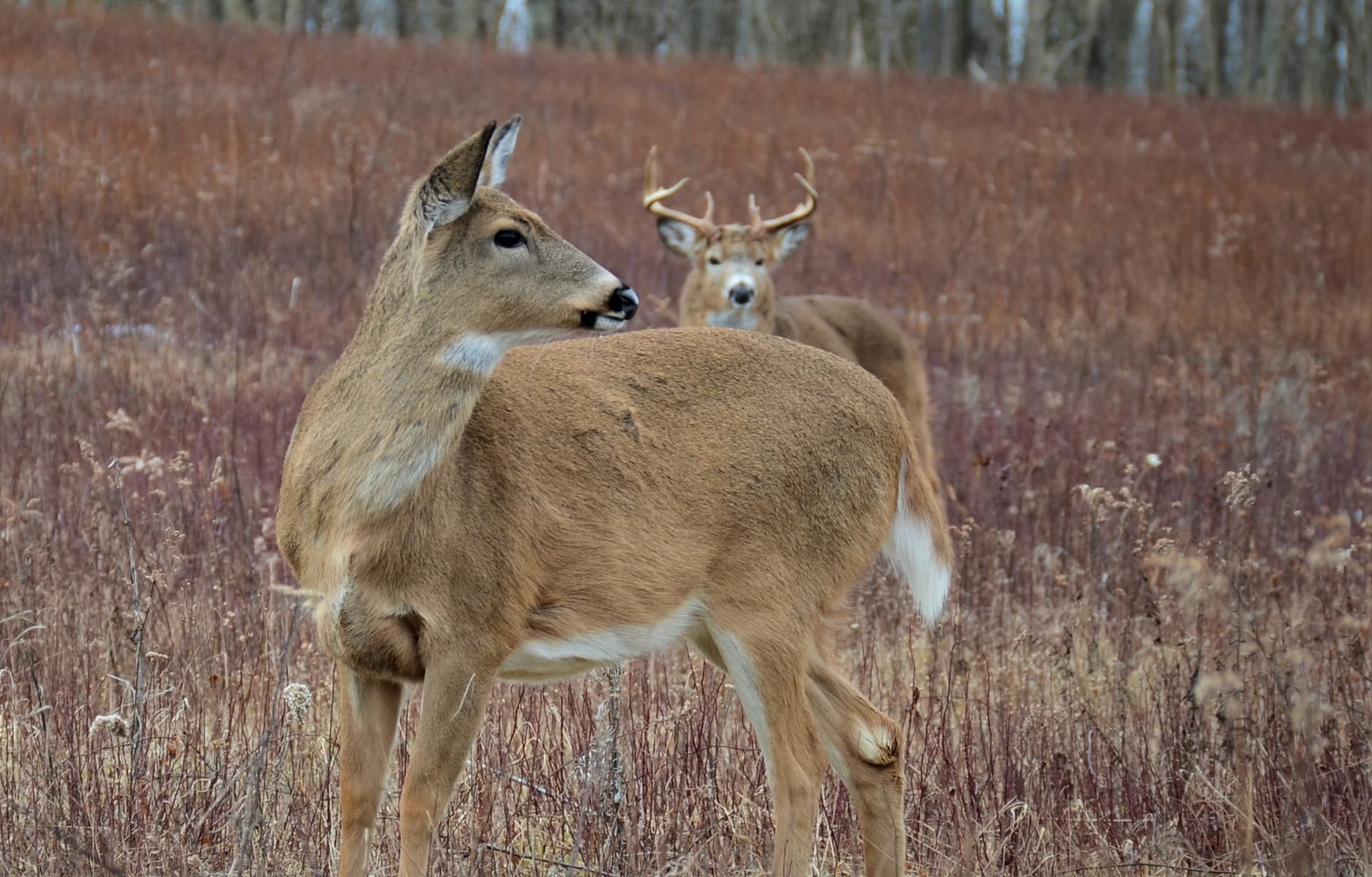

The Whitetail Rut Map is one of the features available in the HuntStand Pro Whitetail upgrade.
As expected, the peak whitetail rut was very consistent in the northern half of the United States, roughly north of a line extending from Oklahoma to North Carolina. North of this line, nearly all
whitetail populations experience a traditional October-November rut. However, south of this line, considerable variation was observed. There are many theories and possible explanations for these variations. However, the vast differences in southern rutting dates are likely a combination of factors. These include latitude, genetics, and stocking source (from deer recovery efforts).
North vs. South
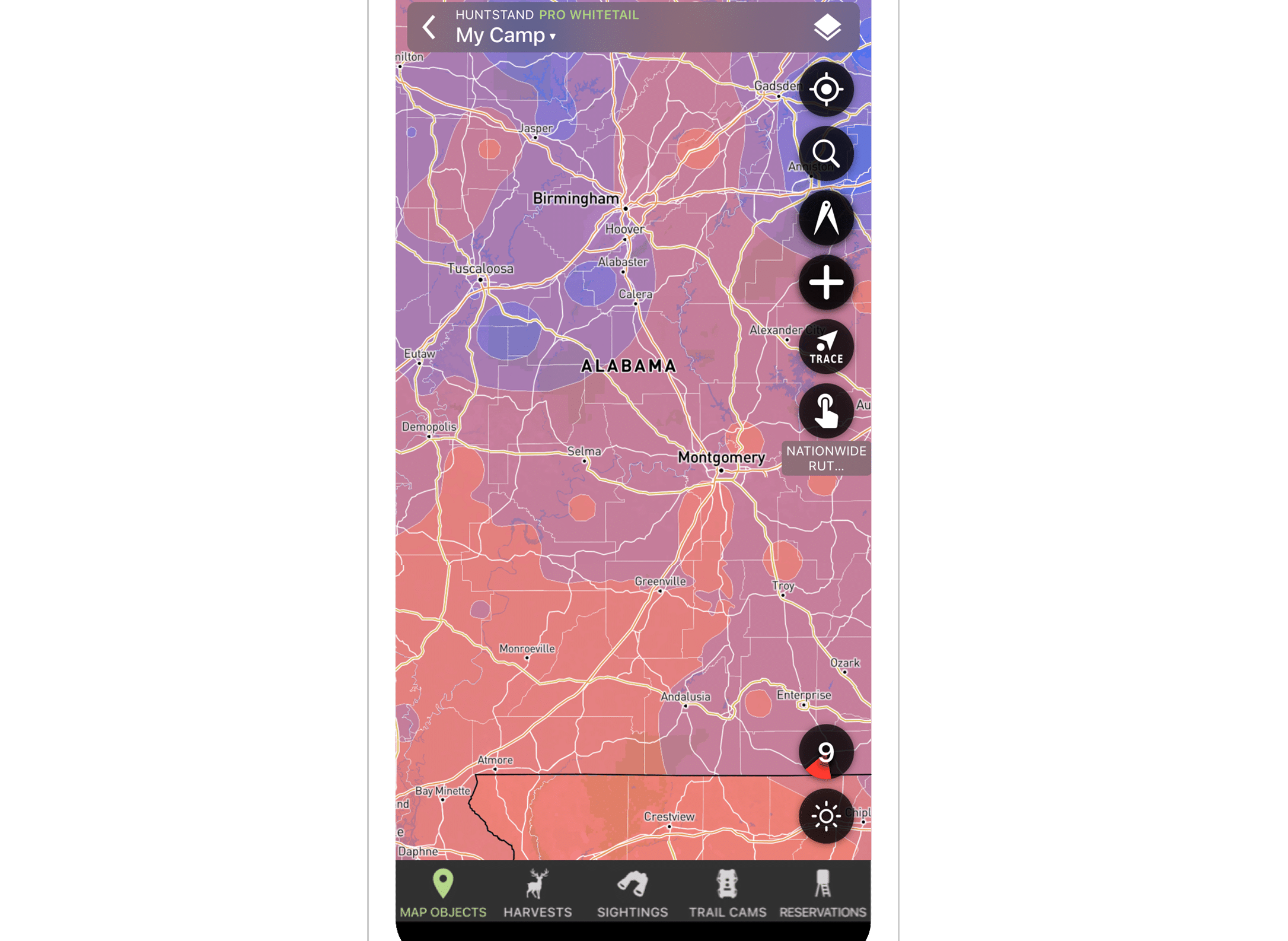

This HuntStand screen shows the color-coded Rut Map in and around Montgomery, Alabama. Each of the colors represents a different two-week peak rut period.
In northern latitudes, late breeding (and therefore late fawning) cannot be perpetuated over time. That’s because of poor fawn survival during winter. In the South, late-born fawns typically survive. This allows individual deer herds to adapt breeding strategies to take advantage of localized weather and habitat conditions. It is also common for deer herds near the equator to breed year-around. So latitude also plays a key role. The whitetail rut extends 210 days (7 months) in the United States, though a rut occurs in nine different calendar months, from July to March. Strange but true.
Rut Timing by Month


All data used for the Whitetail Rut Map was provided by deer biologists from state fish and wildlife agencies, in the 43 states represented on the map.
To examine the distribution of rut timing by month, two approaches were used (see table below). The first was to assign rut start date to month. The second, and perhaps more accurate representation, was to assign the majority of the rut period to the month in which it occurred. For example, if a rut began two days before the end of one month, the bulk of the rut actually occurred in the subsequent month. In such cases, the rut was assigned to the month in which the majority of the two-week rut occurred. As you can see below, this altered the overall “picture” especially with respect to October and November. This is because many ruts begin in the last few days of October, but the bulk of rutting activity occurs in November.
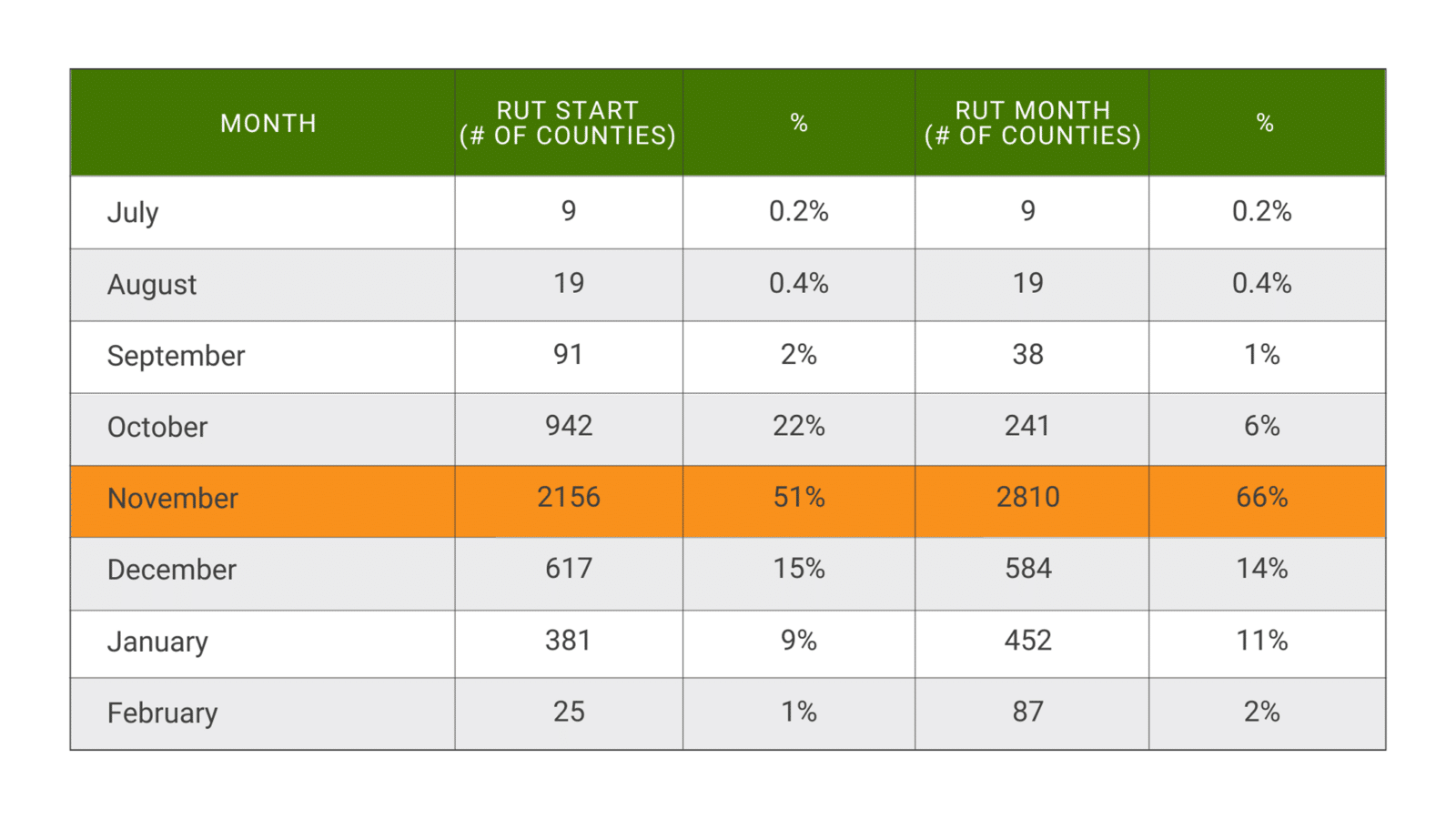
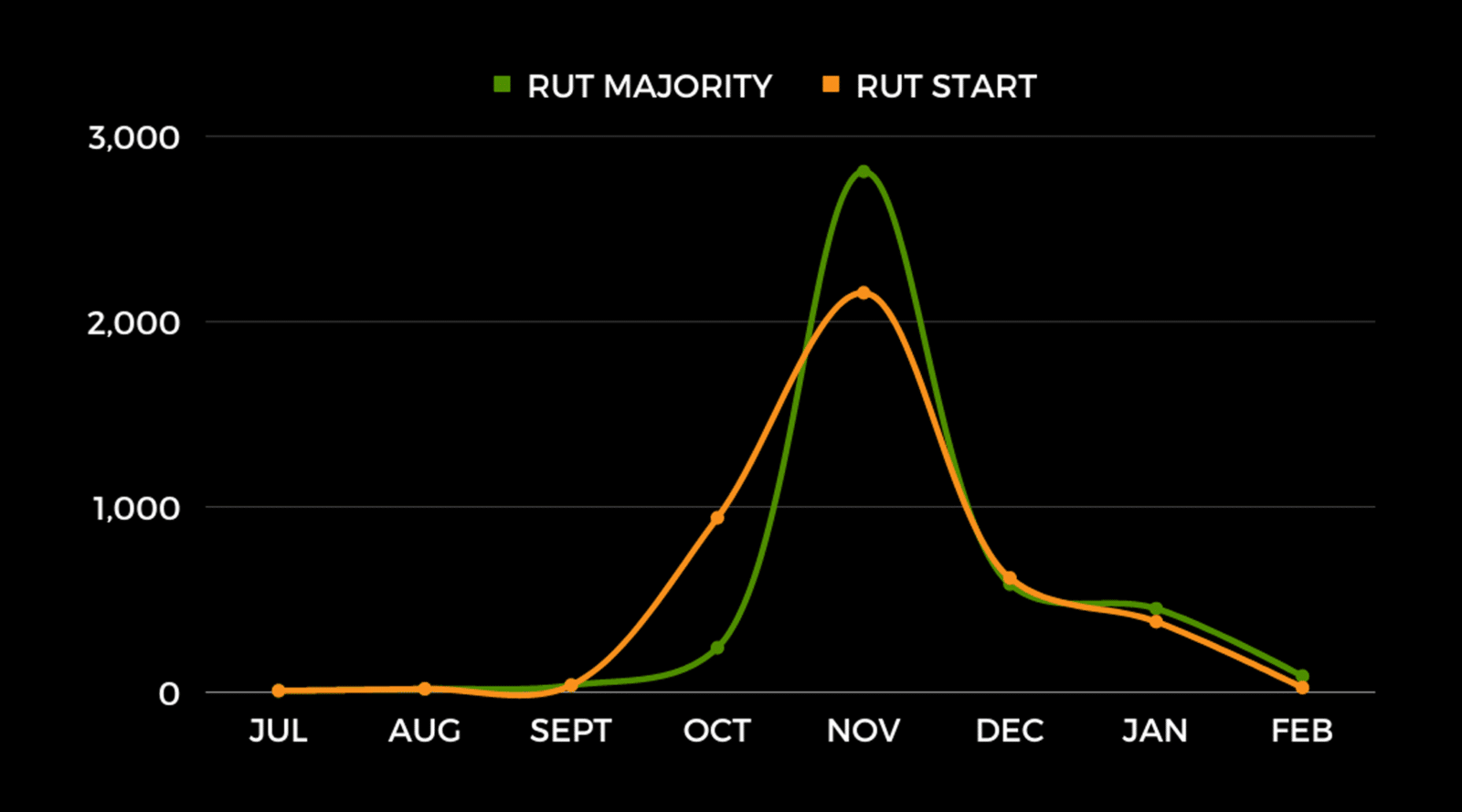
The Rut King: November
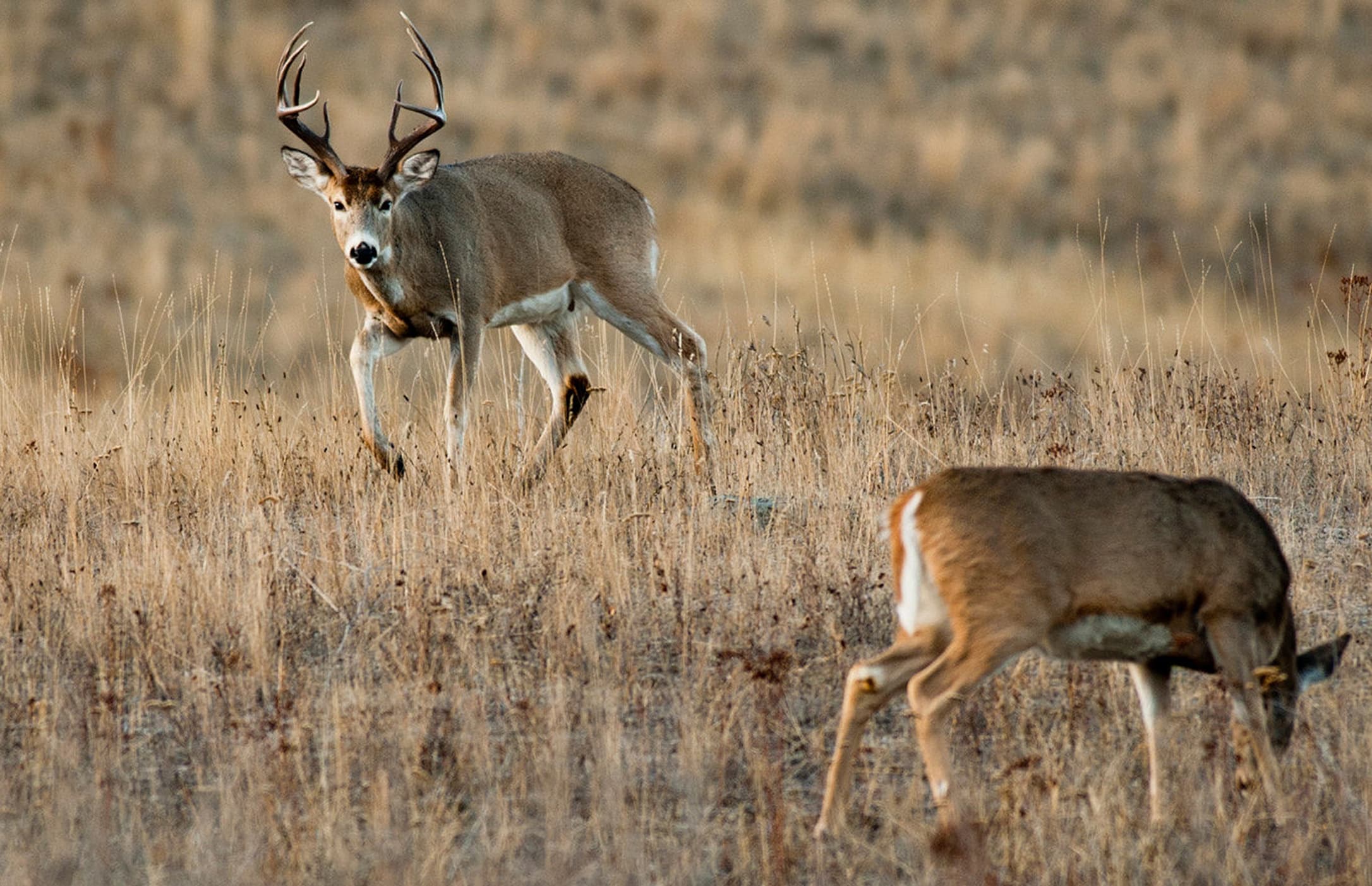

The whitetail rut extends 210 days (7 months) in the United States, though a rut occurs in nine different calendar months, from July to March.
November is the rut “king” with 2,810 counties (66 percent of all counties in the U.S.) experiencing the majority of their ruts during this magical month. This is especially true throughout the Midwest, Northeast, and Northwest, where nearly all whitetail herds rut sometime from the last few of days of October through the end of November.
Some Crazy Rut Dates
Both the earliest (7/22) and latest (2/17) rut starting dates were observed in Florida. Florida holds the distinction of being the only state in which a whitetail rut occurs in nine consecutive calendar months from July to March. In addition, it’s the only state in which you can hunt the rut in July, August, September, or March.


November is the rut “king” with 2,810 counties (66 percent of all counties in the U.S.) experiencing the majority of their ruts during this magical month.
The undisputed late-rut states are MS and AL. Nearly all counties in both states experience ruts in December or January. Florida, Alabama, Mississippi, and Louisiana are the only states in which you can hunt the rut in February.
How to Speed Scout with HuntStand Pro’s Monthly Satellite Imagery
The Unique Texas Rut
Texas is home to a very unique rutting pattern. The Texas rut moves in a counterclockwise pattern starting with the earliest rut in southeast Texas, near Corpus Christi. It then moves north through east Texas, and across the northern and western portions of the state. Eventually it circles back to south Texas for the latest dates, just a few counties from the earliest. This provides a unique three-month rut sequence in the Lone Star State.
Deer Stocking Blamed for Strange Dates
What appears to an anomaly, or possible data error, exists along the border between Georgia and Alabama. This is where the rut dates on either side of the state border vary by up to two months. These dates were investigated in detail with the deer biologists in these states. Following careful review of the data, it was agreed the most-likely explanation was due to the original stocking sources in these areas.
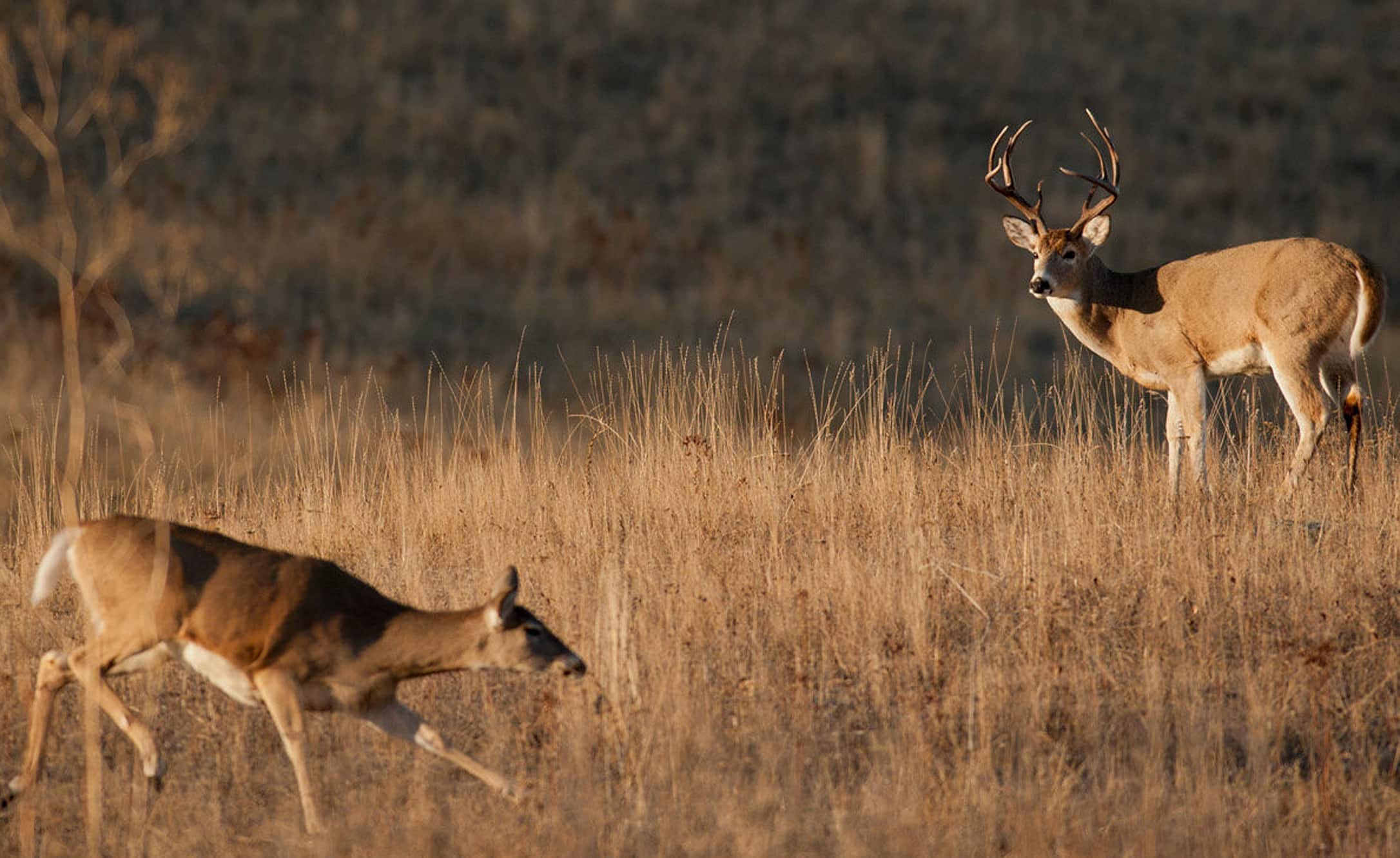

Texas is home to a very unique rutting pattern; the Lone Star State features a three-month rut sequence.
For stocking, Georgia used deer from its coastal populations, with October to early November breeding dates. Alabama, on the other hand, used deer from the southern portions of its state, with a history of breeding in January. It appears these populations have largely retained their breeding strategies. And it’s been more than 50 years since deer were moved to these areas!
Early, Traditional, and Late Ruts
Given that the overall rut occurs over a 210-day period, this offered a convenient way to separate the overall rut into three 70-day periods defined as Early Rut, Traditional Rut, and Late Rut (see table below). This analysis revealed that 3 percent of counties experience an Early Rut, 79 percent a Traditional Rut and 7 percent a Late Rut. Interestingly, there are only four states in which a hunter can hunt the Early Rut and only seven states where Late-Rut hunting opportunities are available. However, hunters can experience a Traditional Rut in all 43 states.

Hunting and Management Uses
It should be noted that this map represents peak conception dates, which does not necessarily mean when bucks are most active. Many hunters realize that buck movement during the peak of breeding can range widely. Things range from periods of intense movement, to the quiet or “lock-down” phase. This is when bucks are tending receptive does in heavy cover. Thus, some other periods may be as good or better, from a buck movement and visibility perspective. These include the days immediately prior to the two-week peak rut period denoted on the map (e.g., pre-rut). In addition, don’t forget the days immediately following peak rut (immediate post-rut).
Find Public-Land Deer Hotspots on the Fly with HuntStand Pro
Second Rut & Fawn Drop
The data from this map can be used to estimate both “second rut” and “fawn drop” dates in any county. To estimate timing of the second rut, simply add 28-30 days to the beginning of the peak rut. To estimate peak fawning dates, add 195-200 days to the beginning of the peak rut. In both cases, these activities will continue in earnest for approximately 14 days from the date calculated.

“This tool is incredibly useful for hunters wanting to determine the best times of the season to hunt locally, as well as knowing where and when to hunt new areas. Experienced hunters know that identifying various stages of the rut is critical to success, and HuntStand’s Whitetail Rut Map makes this quick and easy.”
The second rut can be an effective time to harvest bucks pursuing any adult does that did not breed during the peak rut period, as well as fawn and yearling does that often breed for the first time during the second rut. Identifying the peak fawning period can be useful in timing of predator-removal efforts. It can also be useful to avoid disturbance (mowing/burning/disking) to core fawning areas. This is when fawns are immobile and highly vulnerable.
Just One Feature of Pro Whitetail
Whew. We think you’ll agree that the ground-breaking HuntStand Whitetail Rut Map is a very useful, information-packed tool. And maybe even better, it’s just one component of the HuntStand Pro Whitetail upgrade. If you’re looking to up your whitetail game, do yourself a favor and upgrade today.



